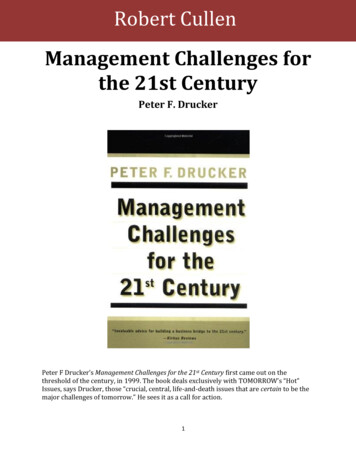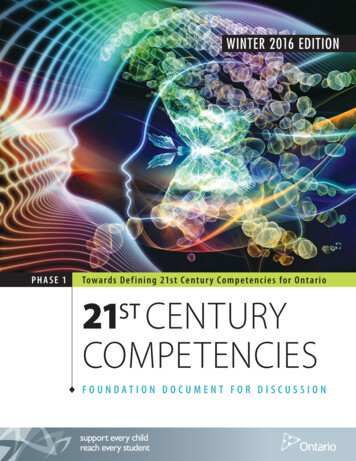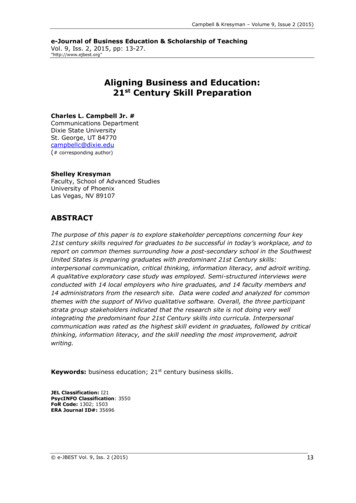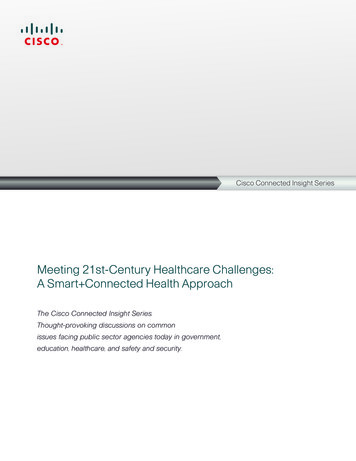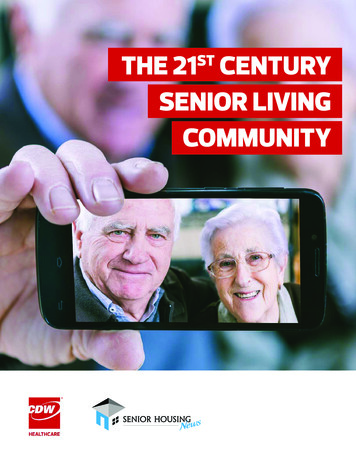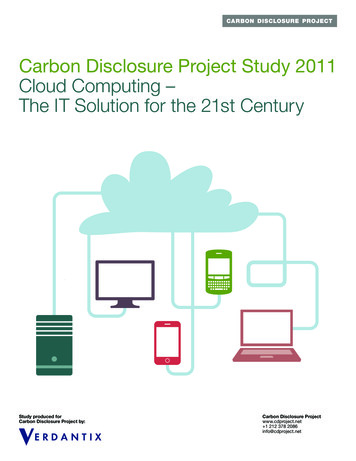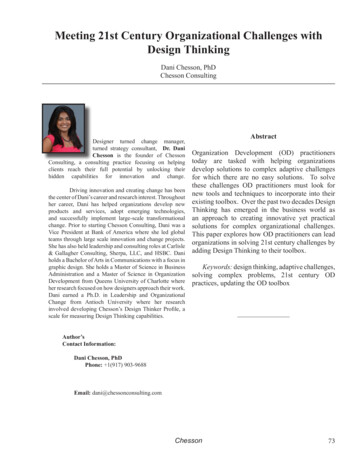
Transcription
Meeting 21st Century Organizational Challenges withDesign ThinkingDani Chesson, PhDChesson ConsultingDesigner turned change manager,turned strategy consultant, Dr. DaniChesson is the founder of ChessonConsulting, a consulting practice focusing on helpingclients reach their full potential by unlocking theirhidden capabilities for innovation and change.Driving innovation and creating change has beenthe center of Dani’s career and research interest. Throughouther career, Dani has helped organizations develop newproducts and services, adopt emerging technologies,and successfully implement large-scale transformationalchange. Prior to starting Chesson Consulting, Dani was aVice President at Bank of America where she led globalteams through large scale innovation and change projects.She has also held leadership and consulting roles at Carlisle& Gallagher Consulting, Sherpa, LLC, and HSBC. Daniholds a Bachelor of Arts in Communications with a focus ingraphic design. She holds a Master of Science in BusinessAdministration and a Master of Science in OrganizationDevelopment from Queens University of Charlotte whereher research focused on how designers approach their work.Dani earned a Ph.D. in Leadership and OrganizationalChange from Antioch University where her researchinvolved developing Chesson’s Design Thinker Profile, ascale for measuring Design Thinking capabilities.AbstractOrganization Development (OD) practitionerstoday are tasked with helping organizationsdevelop solutions to complex adaptive challengesfor which there are no easy solutions. To solvethese challenges OD practitioners must look fornew tools and techniques to incorporate into theirexisting toolbox. Over the past two decades DesignThinking has emerged in the business world asan approach to creating innovative yet practicalsolutions for complex organizational challenges.This paper explores how OD practitioners can leadorganizations in solving 21st century challenges byadding Design Thinking to their toolbox.Keywords: design thinking, adaptive challenges,solving complex problems, 21st century ODpractices, updating the OD toolboxAuthor’sContact Information:Dani Chesson, PhDPhone: 1(917) 903-9688PO BOX 14767New Bern, NC 28561USAEmail: dani@chessonconsulting.comChesson73
The Current State of ges for which there are no easy solutions(Heifetz, 1994; Kegan & Lahey, 2009; Rittel &Webber, 1973). Adaptive challenges are emergingproblems with multiple contributing factors that aredifficult to define and do not have readily availablesolutions. Adaptive challenges require innovativethinking that can introduce new solutions (Brown,2008; Heifetz, 1994; Kegan & Lahey, 2009; Martin,2009). Examples of adaptive challenges in today’sorganizations include keeping pace with the everchanging regulatory environment, retaining anengaged workforce, learning to navigate the rise offreelance workers, leading geographically dispersedand culturally diverse teams, adapting to emergingtechnology, and growing revenues in a globallycompetitive marketplace (Conner, 2013; Helmrich,2016; Lindzon, 2016; Rampton, 2015). These arethe challenges that Organization Development(OD) practitioners today are tasked with helping toresolve.Many organizations lack the capabilitiesneeded to solve the challenges they are facing(Boland & Collopy, 2004; Martin, 2009). DesignThinking is an approach to solution finding thatis well-suited for addressing today’s adaptivechallenges because it focuses on creating innovativeyet practical solutions to tackle adaptive challenges(Brown, 2008; Martin, 2009; Meyer, 2011;Neumeier, 2008).Understanding Design ThinkingTo date, there is no agreed upon concretedefinition of Design Thinking. For the purposesof this paper, Design Thinking is defined as: Aniterative and collaborative process that takes anempathetic approach to problem solving that isparticularly effective when the issue at hand requiressolutions that are innovative yet practical. DesignThinking emphasizes balancing creative thinkingwith analytical thinking, calls for shifting betweengenerating and evaluating ideas, and encouragesconfronting uncertainty by testing out potentialsolutions early in the process to learn what may ormay not work.The popularity of Design Thinking in the74past two decades have been driven by Practitionerssuch as Tim Brown and David Kelley of IDEO.Scholars have also promoted Design Thinkingthrough their call for expanding the practice intoother disciplines to create positive organizationaloutcomes (Brown, 2008; Kimbell, 2011; Martin,2009; Boland & Collopy, 2004). Many scholarshave researched and published in the area ofadapting Design Thinking in the business world(Boland & Collopy, 2004; Owen, 2005; Brown,2008; Martin, 2009; Fraser, 2007; Kimbell, 2011;Lockwood, 2010; Kimbell, 2011; Liedtka &Ogilvie, 2011). The work of Boland & Collopy(2004) for example, discusses how Design Thinkingcan improve management decision making. Theydescribe the job of managers as being selectingthe correct option from a list of existing options.Given the complexity of the challenges facingorganizations today, managers need to move beyondselecting between existing options and engage increating new options. Managers have an in-depthknowledge of their businesses and understand theirchallenges more intimately. Therefore, managersare in best position to know the types of solutionstheir businesses need. The challenge is thatmanagement training historically has not taughtmanagers how to engage in ideation that leads tocreating new options. Design Thinking providesmanagers a framework for driving innovation,so they can create better outcomes for theirorganizations (Brown, 2008; Boland & Collopy,2004; Martin, 2009). The literature provides manyapplications of Design Thinking in business areassuch as product development, service delivery,business growth, and strategic planning (Brown,2008; Conklin, 2005; Owen, 2005; Krippendorff,2006; Lockwood, 2010; Kimbell, 2011; Liedtka &Ogilvie, 2011).Recent research demonstrates theeffectiveness of this approach in business (Brown,2018; Schmiedgen, Rhinow, Köppen, & Meinel,2015). For example, studies show that companiesusing Design Thinking capture 1.5x greater marketshare and increase customer loyalty (Brown,2018; Brozek, 2016). While more research on theeffectiveness of Design Thinking is needed, theinitial findings of these studies support the stance ofscholars that call for organizations to adopt this wayof working.Organization Development Journal l Fall 2018
Figure 1. Design Thinking PurposeDesign Thinking in PracticeThe purpose of Design Thinking is todiscover solutions that are both innovative yetpractical. In this way, Design Thinking seeks tofind solutions that meet the criteria of desirability,viability, and feasibility—see Figure 1 (Brown,2008). Desirable meaning solutions that customerswant because they fulfill a need they have. Viablemeaning solutions that create value for theorganization and will survive in the marketplace.Feasible meaning solutions that are practical froma financial and technical perspective. DesignThinking offers a framework for working thatallows the discovery of solutions that intersect atdesirability, feasibility, and viability.Design Thinking as a MethodologySimilar to how Design Thinking does nothave an agreed upon definition, there is also not oneagreed upon way to engage in Design Thinking.The literature presents multiple process modelsfor engaging in Design Thinking (Brown, 2008;Fraser, 2007; Liedtka & Ogilvie, 2011; Martin,2009). In examining the literature, Chesson (2017)concluded that there are three basic stages forengaging in Design Thinking. All Design Thinkingprocess models have a stage for understandingthe problem, a stage for ideation, and a stage fortesting out solutions. The Chesson model adds anImplementation Stage that focuses on putting thesolutions into action—see Figure 2.The Understanding Stage focuses onFigure 2. Chesson’s Design Thinker Process Modelempathyjourney mappingcollecting storieswho is impacted?how are they impacted?what if ?how might we.?testing to learnprototypingpilotingideationbrainstormingbrain writingmind mappingwhat can we test?how can we test?Chessonhow do we make it real?who must we engage?planning for changecommunicatingdriving action75
exploring the who and the how. Who is impacted?How are they impacted? This stage buildsempathy for the problem and helps us understandwhat a desirable solution might look like. TheConceptualizing Stage focuses on generating aplethora of ideas that may alleviate the problem.The volume of ideas in this stage is importantbecause it increases the likelihood of finding asolution that is workable. This stage builds on theunderstanding developed in the previous stage. TheExperimenting Stage focuses on testing out ideasthat were generated in the previous stage. Thegoal of this stage is to find a solution that can beimplemented. The Implementing Stage focuses onputting a desirable, viable, and feasible solutioninto action.While Design Thinking processes arediscussed in a linear fashion, in practice the processesare iterative. For example, a team may move fromthe Understanding Stage to the ConceptualizingStage and realize they need to learn more aboutthe problem. Therefore, in practice, it is importantto allow space for moving back and forth betweenstages.Design Thinking CapabilitiesDesign Thinking is often discussed as aprocess or a methodology to follow. However,Design Thinking is much more than a methodologyand viewing it only as such limits its full potential forproblem solving. Design Thinking is a philosophy,a mindset, a methodology, and a set of capabilities.Learning the Design Thinking process provides anentree to understanding this approach but, to trulymaster this way of working we must go beyondjust following the process—we must also buildthe capabilities, and adopt the mindset (Chesson,2017). The philosophy of Design Thinking iscovered earlier in this paper—see UnderstandingDesign Thinking. The previous section coversthe methodology of Design Thinking—see DesignThinking as a Methodology.The followingparagraphs discuss the capabilities of DesignThinking.Design Thinkers - those that engage inDesign Thinking - are optimistic about findingsolutions (Brown, 2008; Owen, 2005; Simon,1969). They see constraints as being part of theprocess and do not let obstacles get in the way of76creating solutions. Design Thinkers are empatheticand interested in the experiences of human beings(Brown, 2008; Fraser, 2007; Junginger, 2007;Lawson, 2006; Liedtka and Ogilvie, 2011; Martin,2009). They aim to understand a problem fromthe perspective of those that are impacted bythe problem. They are idea generators. Whenpresented with a problem, Design Thinkers canimagine many potential ways of solving thechallenge. Design Thinkers are visually expressive(Lawson, 1979, 2006; Liedtka and Ogilvie, 2011;Owen, 2005). While not all Design Thinkers aretalented artists, they are comfortable with visualtechniques such sketching, diagramming, and mindmapping. Design Thinkers use these techniquesto communicate, explore, and reflect on ideas.Design Thinkers harness the power of collaborationbecause they know that good solutions do not comeabout in isolation. They pro actively work to engageothers in the solution finding process. DesignThinkers are comfortable with uncertainty andunderstand that creating something new requiresexploring unknown spaces (Fraser, 2007; Martin,2009; Owen, 2005). Design Thinkers confrontthe unknown by testing out solutions, exploringoptions, and learning from failed experiments.Collectively these are the capabilities needed toengage in Design Thinking. These capabilities arenot absolutes (meaning you either have them or youdon’t). These capabilities exist in all of us to somedegree but not all of us have had the opportunityto develop them fully (Chesson, 2017). Throughmindful practice we can develop these skills andbecome innovative problem solvers.Organization Development ConsultingOrganizations when faced with challengesthey cannot overcome alone turn to OD practitionersfor support. The OD literature offers a frameworkfor how OD Practitioners engage with clients.This framework is referred to as the organizationdevelopment consulting process (Anderson, 2012).Throughout the literature there are various iterationsof this process. As described by Anderson (2012),there are seven stages to the OD consulting process.These stages are: Entering, Contracting, DataGathering, Diagnosing, Feedback, Intervention,Evaluation, and Exit.Organization Development Journal l Fall 2018
The Entering StageThis stage is all about building relationships,gaining trust, and understanding the needs ofpotential clients. This stage consists of businessdevelopment activities to create awareness amongpotential clients (Freedman & Zackrison, 2001).Activities in this phase can include making calls,presenting at conferences, advertising, and informalmeetings with prospective clients.The Contracting StageOnce a client has expressed an interest inengaging the OD Practitioner in a scope of work,the process moves to the Contracting Stage. Thisstage is about understanding the challenges theclient is facing and defining the scope of work. Asthe issues are discussed, the OD Practitioner workswith the client to document the scope of work to bedone, the steps in the process, the length of time,and payment—this is the formal aspect of this stage.There is also a psychological aspect to this stagewhich involves, coming to a mutual understandingof how the client and OD Practitioner will worktogether (Schein, 1969). This may include thelevel of involvement the OD Practitioner has in theorganization, the method of communication, andoutlining expectations (Boss, 2000).The Data Gathering StageIn this stage, the OD Practitioner engageswith other members of the organization to collectinformation about the initial problem defined inthe previous stage. The purpose of this stage is toconfirm and deepen the understanding of the issue(Argyris, 1970; Block, 2001; & Nadler, 1977). ODPractitioners may use a variety of methods such asinterviews, surveys, observations, and focus groupsto collect data (Anderson, 2012).The Diagnosing StageThis stage involves using the data collectedto diagnose the problem. The data analysis methodused is determined by how the data were collected(Anderson, 2012). For example, if data collectionwas done through interviews, thematic analysismay be used to sort and organize the informationcollected. Conversely, if surveys were used,statistical analysis may be used to analyze andorganize the information collected. This stage ismost successful when OD Practitioners engagemembers of the organization in the data analysisprocess (Bartee & Cheyunski, 1977; Moates,Armenakis, Gregory, Albritton, & Field, 2005).Once the data is sorted and analyzed, the ODPractitioner prepares to give feedback to the client.The Feedback StageThe goal of this stage is to help organizationsunderstand its behaviors and learn what they cando to improve their situation (Manzini, 1988).Feedback can be provided as part of a written reportor presentation at a meeting. The goal of this stageis to provide information that creates awareness andalso inspires action toward resolving the issue. Forthis purpose, it is recommended that feedback isdone through a meeting where the organization canactively be engaged in a discussion (Argyris, 1970;Nadler, 1977, Anderson, 2012).The Intervention StageThis stage consists of two parts. Firstis selecting the intervention and planning foraction. Second is implementing the interventionby executing the action plan (Anderson, 2012). Inthe planning process, it is important for the ODPractitioner to assess the organization’s readiness forchange and support the organization in overcomingresistance.Evaluation and Exit StageIn this stage, the OD Practitioner evaluatesthe effectiveness of the intervention and develops atransition plan to exit the engagement (Anderson,2012). In the process of evaluating the interventionthe organization may identify new scopes of workfor the OD Practitioner to assist with. In thiscase, the OD Practitioner completes the existingengagement and begins again in the Entering Stagefor the new scope of work.The professional responsibility of the ODpractitioner is to help organizations build their owncapabilities and create solutions to challenges theorganization is not able to solve on their own. Byengaging the organization throughout the consultingprocess, OD practitioners help create awarenessand help the organization build the capabilities theylack.Chesson77
Bringing Design Thinking into OrganizationDevelopment PracticeAs discussed earlier in this paper,organizations today are facing complex challengesfor which there are no readily available responses.Design Thinking is as an approach that is well-suitedfor handling these types of challenges (Brown,2008; Martin, 2009; Meyer, 2011; Neumeier, 2008).As we consider what organization developmentcould be in the 21st Century, Design Thinkingoffers some ways to enhance the organizationdevelopment process to better meet the challengesof today.Empathy in Organization DevelopmentConsultingDesign Thinking calls for humancenteredness and empathy. In practice, this translatesto understanding the needs of those we serve(clients) so well that we can see situations throughtheir eyes and we can walk a mile in their shoes(Liedtka & Ogilvie, 2011; Stickdorn, Lawrence,Hormeß, Schneider, 2018).Design Thinkersbelieve that without empathy we cannot delivermeaningful solutions that make a difference. In aglobal marketplace where technology is advancingrapidly, the ability to connect with customers anddeliver solutions that meet their latent needs iscritical to business success. Journey mapping is atechnique used in Design Thinking to gain empathyfor the challenges clients face. Journey maps arevisual illustrations of how an organization interactswith their customers (Liedtka & Ogilvie, 2011;Stickdorn, Lawrence, Hormeß, Schneider, 2018).Journey maps can be created at a macro-level suchas incorporating the entire firm or the micro-levelsuch as a specific service offered by an organization.These maps help organizations understand theirbusiness from various perspectives.OD practitioners can incorporate journeymapping in the Contracting Stage when workingto understand the challenges their client is facing.Here the OD practitioner may use the journeymapping technique to have the client walk throughthe process where the issue is occurring and isolatewhere in the journey the challenges arise. Journeymaps bring a client’s story to life and the ODpractitioner sees what the client sees, hears, feels,78and does in their day-to-day life. This techniquehelps the OD practitioner develop empathy forthe client while also helping the client understandtheir own situation. Having empathy and deeplyunderstanding the challenges clients face will allowOD practitioners to deliver better organizationaloutcomes.Journey mapping may also prove usefulin the Data Gathering stage. Keeping in mindthat journey mapping occurs at different levels,the OD practitioner may build on a journey mapdeveloped in the Contracting stage, and dive deeperinto examine the organization more closely. Indata gathering, journey mapping could be coupledwith current techniques used by OD practitionerssuch as interviews and surveys. For example, ODpractitioners could use surveys to collect data thenengage members of the organization to plot thedata collected on a journey map to tell the story.This visual map could then be used in the feedbackstage to illustrate the challenges the organization isfacing.Ideation in Organization DevelopmentConsultingBoth Design Thinking and organizationdevelopment encourage collaboration in the solutionfinding process. Members of the organization aremore likely to support solutions they help create,making adoption of the solution much easier(Kotter, 2011). To find solutions Design Thinkingencourages generating an ample supply of ideasand offers various techniques to inspire teamsto engage in ideation (Liedtka & Ogilvie, 2011;Stickdorn, Lawrence, Hormeß, Schneider, 2018).One commonly used technique for idea generationis brainstorming. The process involves a teamgathering to verbally share ideas while a facilitatorcaptures the thoughts that are shared. This approachis often criticized because it may not be welcomingfor individuals that are reluctant to speak up in groupsor need quiet reflection to be creative. However,done properly brainstorming can be effective inbringing forward innovative ideas. Liedtka andOgilvie, 2011 provide a detailed framework foreffectively facilitating brainstorming. Anothertechnique used in Design Thinking is brain writing(Stickdorn, Lawrence, Hormeß, Schneider, 2018).As the name suggests this technique captures ideasOrganization Development Journal l Fall 2018
in writing and works well to ensure that everyone’sideas are captured. Similar to brainstorming,in brain writing a small group gathers however,instead of group members verbally sharing ideas,the ideas are captured in writing. Each member ofthe group is provided a sheet of paper and a pen.They are asked to a come up with a specific numberof ideas within a given time frame. When time isup, each member of the group passes their sheet ofpaper to the person on their right (or left). Thenthe writing exercise is repeated. In the subsequentrounds, team members are asked to read the ideasalready on the paper and either build on those ideasor add new ones. This process continues until eachteam member has written on each sheet of paper.The Design Thinking literature offers severalother techniques for ideation (Liedtka & Ogilvie,2011; Stickdorn, Lawrence, Hormeß, Schneider,2018). Similar to selecting an OD intervention, ODPractitioners should pay mind to the purpose andorganizational culture when selecting an ideationmethod. Regardless of the method used to ideate,Design Thinking encourages beginning the processby setting the context. This can be accomplishedby having teams either participate in collectinginformation about the problem or reviewing datathat has already been gathered.Ideation techniques can be used in theIntervention Stage to engage the organization indeveloping solutions to the challenges they face.These techniques work best when teams understandthe problem for which they are ideating. Therefore,these activities serve as a complement to theFeedback Stage. Here the OD Practitioner couldplan an ideation session to take place after feedbackis provided to the client.Prototyping in Organization DevelopmentConsultingDesign Thinking calls for creating tangibleexperiences of proposed solutions to understandif a solution is viable and feasible (Brown, 2008).Prototyping enables ideas to evolve and potentialissues to be identified early on before organizationsinvest resources to implement a solution. TheDesign Thinking toolbox offers many techniquesfor prototyping however; the theatrical approachesmay be the most appropriate for the practice of OD.The theatrical approaches to prototyping involveteam members acting out scenarios to understandhow a solution might work (Stickdorn, Lawrence,Hormeß, Schneider, 2018). One method forprototyping is called the desktop walk-through.With this technique, teams create maps, smallscale models, and use figurines to walk throughthe proposed solution. This process allows theorganization to see how the solution will work,identify any pitfalls, and make any improvementsprior to implementing.Prototyping techniques can be used in theIntervention Stage. Here OD Practitioners couldhave the organization test out several potentialinterventions to understand how they will work.In doing so, they may be able to identify if anintervention is not feasible or come up with ideasto improve a solution. Additionally, prototypingprovides another opportunity for OD practitionersto engage the client in developing solutions.When organizations are engaged in the process,we can create solutions that better meet the needsof our clients and increase the likelihood of thechange being adopted (Kotter, 2011). In this way,prototyping may allow OD practitioners to delivermore successful interventions.ConclusionTraditionally, Design Thinking has beenassociated with iconic companies known for designsuch as Apple, Samsung, and Nike. However,in recent times the approach has extended toorganizations outside of the design sector. Today,companies such as Kaiser Permanente, IBM, andgovernment agencies like the Australian TaxationOffice and the National Health Service of the UKare using Design Thinking to improve patientcare, deliver better customer service, identifyunmet customer needs, and create more efficientorganizations (Bevan, Robert, Bates, Maher &,Wells, 2007; Body, 2008). These examples illustratethat Design Thinking is no longer a “nice-to-have”or limited to iconic design firms. Design Thinking isaccessible to all organizations and can help improveorganizational capabilities for delivering solutionsto complex adaptive challenges. By combiningDesign Thinking with the proven practices oforganizational development, OD practitionerscan lead organizations in solving 21st CenturyChesson79
Referenceschallenges. 80Anderson, D. L. (2012). The organizationdevelopment OD Practitioner and theconsultingprocess.Organizationaldevelopment: The process of leadingorganizational change (Second Edition).Los Angeles, CA: SAGE Publications.Argyris, C. (1970). Intervention theory and method:A behavioral science view. Reading, MA:Addison-Wesley.Bartee, E. M., & Cheyunski, F. (1977). Amethodologyforprocess-orientedorganizational diagnosis. Journal of AppliedBehavioral Science, 13, 53-68.Bevan, H., Robert, G., Bate, P., Maher, L., & Wells,J. (2007). Using a design approach to assistlarge-scale organizational change: “10 highimpact changes” to improve the NationalHealth Service in England. Journal ofApplied Behavioral Science, 43(1), Block, P. (2001). Twelve questions to the mostfrequently asked answers. In P. Block(Ed.), The flawless consulting fieldbook andcompanion (pp. 393-403). San Francisco,CA: Bossey-Bass.Body, J. (2008). Design in the Australian TaxationOffice. Design Issues, 24(1), 55–67. https://doi.org/10.1162/desi.2008.24.1.55Boss, R. W. (2000). The psychological contract.In R. T. Golembiewski (Ed.), Handbook oforganizational consultation (2nd ed). NewYork, NY: Marcel Dekker.Boland, R. J., & Collopy, F. (2004). Design mattersfor management. Stanford, CA: StanfordUniversity Press.Brown, B. (2018). The Total Economic Impact ofIBM’s Design Thinking Practice. 9e1.pdfBrozek, C. M. (2016). Design-led firms winthe business advantage. Retrieved lBrown, T. (2008). Design Thinking. HarvardBusiness Review, 86(6), 84–94. RetrievedOrganization Development Journal l Fall 2018
, R. (1992). Wicked problems in DesignThinking. Design Issues, 8(2), 5–21. https://doi.org/10.2307/1511637Chesson, D. (2017). Design Thinker Profile:Creating and Validating a Scale forMeasuring Design Thinking Capabilities(Doctoral dissertation, Antioch University).Conklin, J. (2005). Dialogue mapping: Buildingshared understanding of wicked problems.New York, NY: Wiley.Conner, C. (2013, March 4). The 8 greatchallenges every business faces (and howto master them all). Forbes. b9Fraser, H. M. (2007). The practice of breakthroughstrategies by design. Journal of 1108/02756660710760962Freedman, A. M., & Zackrison, R. E. (2001).Finding your way in the consulting jungle:A guidebook for organization developmentpractitioners. San Francisco, CA: JosseyBass/Pfeiffer.Heifetz, R. A. (1994). Leadership without easyanswers. Boston, MA: Harvard UniversityPress.Helmrich, B. (2016, March 14). 10 challengesCEOs will face in 2016. Business y.com/3625-new-yearchallenges.htmlJunginger, S. (2007). Learning to design: Givingpurpose to heart, hand, and mind. Journalof Business Strategy, 28(4), 59–65. https://doi.org/10.1108/02756660710760953Kegan, R., & Lahey, L. L. (2009). Immunity tochange: How to overcome it and unlockpotential in yourself and your organization.Boston, MA: Harvard Business Press.Kimbell, L. (2011). Rethinking Design Thinking:Part I. Design & Culture, 3(3), 66525216Krippendorff, K. (2006). The semantics turn: Anew foundation for design. Boca Raton, FL:Taylor & Francis.Kotter, J. P. (2011). Leading change. Boston, MA:Harvard Business Press.Lawson, B. (1979). Cognitive strategies inarchitectural design. Ergonomics, 22(1),59–68. https://doi.org/10.1080/00140137908924589Lawson, B. (2006). How designers think: Thedesign process demystified (4th ed.). SanFrancisco, CA: Routledge.Liedtka, J., & Ogilvie, T. (2011). Designing forgrowth: A Design Thinking tool kit formanagers. West Sussex, NY: ColumbiaUniversity Press.Lindzon, J. (2016, January 13). These will be thetop 5 business challenges of 2016. FastCompany. Retrieved from 2016Lockwood, T. (2010). Design Thinking: Integratinginnovation, customer experience, and brandvalue. New York, NY: Skyhorse.Manzini, A. O. (1988). Organizational diagnosis:A practical
Design Thinking is often discussed as a process or a methodology to follow. However, Design Thinking is much more than a methodology and viewing it only as such limits its full potential for problem solving. Design Thinking is a philosophy, a mindset, a methodology, and a set of capabilities. Learning


